I
S
B
)
c
(
,
0
3
:
6
0
1
1
0
2
/
1
0
/
0
2
f
o
s
a
t
c
e
r
r
o
c
n
o
s
r
e
V
i
,
s
n
k
t
A
i
,
g
n
o
h
o
a
B
u
W
r
M
:
y
p
o
c
d
e
s
n
e
c
L
i
BSI Standards Publication
NO COPYING WITHOUT BSI PERMISSION EXCEPT AS PERMITTED BY COPYRIGHT LAW
raising standards worldwide™
BS EN 50159:2010Railway applications —Communication, signallingand processing systems —Safety-related communicationin transmission systems�
BS EN 50159:2010
BRITISH STANDARD
National foreword
This British Standard is the UK implementation of EN 50159:2010. It
supersedes BS EN 50159-1:2001 and BS EN 50159-2:2001 which are
withdrawn.
The UK participation in its preparation was entrusted to Technical
Committee GEL/9, Railway Electrotechnical Applications.
A list of organizations represented on this committee can be
obtained on request to its secretary.
This publication does not purport to include all the necessary
provisions of a contract. Users are responsible for its correct.
application.
© BSI 2010
ISBN 978 0 580 67552 2
ICS 35.240.60; 45.020
Compliance with a British Standard cannot confer immunity from
legal obligations.
This British Standard was published under the authority of the
Standards Policy and Strategy Committee on 31 October 2010.
Amendments issued since publication
Date
Text affected
I
S
B
)
c
(
,
0
3
:
6
0
1
1
0
2
/
1
0
/
0
2
f
o
s
a
t
c
e
r
r
o
c
n
o
s
r
e
V
i
,
s
n
k
t
A
i
,
g
n
o
h
o
a
B
u
W
r
M
:
y
p
o
c
d
e
s
n
e
c
L
i
�
EUROPEAN STANDARD
NORME EUROPÉENNE
EUROPÄISCHE NORM
ICS 35.240.60; 45.020
BS EN 50159:2010
EN 50159
September 2010
Supersedes EN 50159-1:2001, EN 50159-2:2001
English version
Railway applications -
Communication, signalling and processing systems -
Safety-related communication in transmission systems
Applications ferroviaires -
Systèmes de signalisation,
de télécommunication et de traitement -
Communication de sécurité sur
des systèmes de transmission
Bahnanwendungen -
Telekommunikationstechnik,
Signaltechnik und
Datenverarbeitungssysteme -
Sicherheitsrelevante Kommunikation
in Übertragungssystemen
This European Standard was approved by CENELEC on 2010-09-01. CENELEC members are bound to
comply with the CEN/CENELEC Internal Regulations which stipulate the conditions for giving this European
Standard the status of a national standard without any alteration.
Up-to-date lists and bibliographical references concerning such national standards may be obtained on
application to the Central Secretariat or to any CENELEC member.
This European Standard exists in three official versions (English, French, German). A version in any other
language made by translation under the responsibility of a CENELEC member into its own language and
notified to the Central Secretariat has the same status as the official versions.
CENELEC members are the national electrotechnical committees of Austria, Belgium, Bulgaria, Croatia,
Cyprus, the Czech Republic, Denmark, Estonia, Finland, France, Germany, Greece, Hungary, Iceland,
Ireland, Italy, Latvia, Lithuania, Luxembourg, Malta, the Netherlands, Norway, Poland, Portugal, Romania,
Slovakia, Slovenia, Spain, Sweden, Switzerland and the United Kingdom.
CENELEC
European Committee for Electrotechnical Standardization
Comité Européen de Normalisation Electrotechnique
Europäisches Komitee für Elektrotechnische Normung
Management Centre: Avenue Marnix 17, B - 1000 Brussels
© 2010 CENELEC - All rights of exploitation in any form and by any means reserved worldwide for CENELEC members.
Ref. No. EN 50159:2010 E
I
S
B
)
c
(
,
0
3
:
6
0
1
1
0
2
/
1
0
/
0
2
f
o
s
a
t
c
e
r
r
o
c
n
o
s
r
e
V
i
,
s
n
k
t
A
i
,
g
n
o
h
o
a
B
u
W
r
M
:
y
p
o
c
d
e
s
n
e
c
L
i
�
BS EN 50159:2010
EN 50159:2010
– 2 –
Foreword
This European Standard was prepared by SC 9XA, Communication, signalling and processing systems, of
Technical Committee CENELEC TC 9X, Electrical and electronic applications for railways. It was
submitted to the formal vote and was approved by CENELEC as EN 50159 on 2010-09-01.
This document supersedes EN 50159-1:2001 and EN 50159-2:2001.
The contents of both standards have been merged; the informative Annex E gives a mapping between these
previous editions and the present document.
This European Standard is closely related to EN 50129:2003.
Attention is drawn to the possibility that some of the elements of this document may be the subject of
patent rights. CEN and CENELEC shall not be held responsible for identifying any or all such patent rights.
The following dates were fixed:
–
–
latest date by which the EN has to be implemented
at national level by publication of an identical
national standard or by endorsement
latest date by which the national standards conflicting
with the EN have to be withdrawn
(dop)
(dow)
2011-09-01
2013-09-01
This draft European Standard has been prepared under a mandate given to CENELEC by the European
Commission and the European Free Trade Association and covers essential requirements of
EC Directives 96/48/EC (HSR), recast by EC Directives 2008/57/EC (RAIL). See Annex ZZ.
__________
I
S
B
)
c
(
,
0
3
:
6
0
1
1
0
2
/
1
0
/
0
2
f
o
s
a
t
c
e
r
r
o
c
n
o
s
r
e
V
i
,
s
n
k
t
A
i
,
g
n
o
h
o
a
B
u
W
r
M
:
y
p
o
c
d
e
s
n
e
c
L
i
�
– 3 –
Contents
BS EN 50159:2010
EN 50159:2010
Introduction .................................................................................................................................................. 5
1 Scope .................................................................................................................................................... 6
2 Normative references .......................................................................................................................... 7
3
Terms, definitions and abbreviations ................................................................................................ 7
3.1 Terms and definitions .................................................................................................................. 7
3.2 Abbreviations ............................................................................................................................. 12
4 Reference architecture ...................................................................................................................... 13
5
Threats to the transmission system ................................................................................................ 16
6 Classification of transmission systems .......................................................................................... 17
6.1 General ...................................................................................................................................... 17
6.2 General aspects of classification ............................................................................................... 17
6.3 Criteria for the classification of transmission systems ............................................................... 17
6.4 Relationship between transmission systems and the threats .................................................... 18
7 Requirements for defences ............................................................................................................... 18
7.1 Preface ...................................................................................................................................... 18
7.2 General requirements ................................................................................................................ 19
7.3 Specific defences ...................................................................................................................... 20
7.4 Applicability of defences ............................................................................................................ 26
Annex A (informative) Threats on open transmission systems ............................................................ 28
A.1 System view ............................................................................................................................... 28
A.2 Derivation of the basic message errors ..................................................................................... 29
A.3 Threats....................................................................................................................................... 30
A.4 A possible approach for building a safety case ......................................................................... 31
A.5 Conclusions ............................................................................................................................... 35
Annex B (informative) Categories of transmission systems ................................................................. 37
B.1 Categories of transmission systems .......................................................................................... 37
B.2 Relationship between the category of transmission systems and threats ................................. 39
Annex C (informative) Guideline for defences ........................................................................................ 40
C.1 Applications of time stamps ....................................................................................................... 40
C.2 Choice and use of safety codes and cryptographic techniques................................................. 41
C.3 Safety code ................................................................................................................................ 46
C.4 Length of safety code ................................................................................................................ 49
C.5 Communication between safety-related and non safety-related applications............................ 51
Annex D (informative) Guidelines for use of the standard..................................................................... 53
D.1 Procedure .................................................................................................................................. 53
D.2 Example ..................................................................................................................................... 54
Annex E (informative) Mapping from previous standards ..................................................................... 59
Annex ZZ (informative) Coverage of Essential Requirements of EC Directives ................................ 62
Bibliography ............................................................................................................................................... 63
I
S
B
)
c
(
,
0
3
:
6
0
1
1
0
2
/
1
0
/
0
2
f
o
s
a
t
c
e
r
r
o
c
n
o
s
r
e
V
i
,
s
n
k
t
A
i
,
g
n
o
h
o
a
B
u
W
r
M
:
y
p
o
c
d
e
s
n
e
c
L
i
�
I
S
B
)
c
(
,
0
3
:
6
0
1
1
0
2
/
1
0
/
0
2
f
o
s
a
t
c
e
r
r
o
c
n
o
s
r
e
V
i
,
s
n
k
t
A
i
,
g
n
o
h
o
a
B
u
W
r
M
:
y
p
o
c
d
e
s
n
e
c
L
i
BS EN 50159:2010
EN 50159:2010
– 4 –
Figures
Figure 1 – Reference architecture for safety-related communication .......................................................... 15
Figure 2 – Cyclic transmission of messages ............................................................................................... 21
Figure 3 – Bi-directional transmission of messages .................................................................................... 22
Figure A.1 – Hazard tree ............................................................................................................................. 29
Figure A.2 – Causes of threats .................................................................................................................... 32
Figure C.1 – Classification of the safety-related communication system .................................................... 42
Figure C.2 – Model of message representation within the transmission system (Type A0, A1) ................. 43
Figure C.3 – Use of a separate access protection layer .............................................................................. 44
Figure C.4 – Model of message representation within the transmission system (Type B0) ........................ 45
Figure C.5 – Model of message representation within the transmission system (Type B1) ........................ 46
Figure C.6 – Basic error model .................................................................................................................... 49
Figure C.7 – Communication between non safety-related and safety-related applications ......................... 52
Figure D.1 – Fault tree for the hazard “accident” ......................................................................................... 55
Figure D.2 – Fault tree for case 1 ................................................................................................................ 56
Figure D.3 – Fault tree for case 2 ................................................................................................................ 58
Tables
Table 1 – Threats/Defences matrix ............................................................................................................. 26
Table A.1 – Relationship between hazardous events and threats ............................................................... 36
Table B.1 – Categories of transmission systems ........................................................................................ 38
Table B.2 – Threat/Category relationship .................................................................................................... 39
Table C.1 – Assessment of the safety encoding mechanisms ................................................................... 48
Table E.1 – Mapping from EN 50159-1:2001 into EN 50159:201X ............................................................. 60
Table E.2 – Mapping from EN 50159-2:2001 into EN 50159:201X ............................................................. 61
�
– 5 –
BS EN 50159:2010
EN 50159:2010
Introduction
If a safety-related electronic system involves the transfer of information between different locations, the
transmission system then forms an integral part of the safety-related system and it shall be shown that the
end to end communication is safe in accordance with EN 50129.
The transmission system considered in this standard, which serves the transfer of information between
different locations, has in general no particular preconditions to satisfy. It is from the safety point of view
not trusted, or not fully trusted.
The standard is dedicated to the requirements to be taken into account for the communication of safety-
related information over such transmission systems.
Although the RAM aspects are not considered in this standard it is recommended to keep in mind that
they are a major aspect of the global safety.
The safety requirements depend on the characteristics of the transmission system. In order to reduce the
complexity of the approach to demonstrate the safety of the system, transmission systems have been
classified into three categories:
– Category 1 consists of systems which are under the control of the designer and fixed during their
lifetime;
– Category 2 consists of systems which are partly unknown or not fixed, however unauthorised access
can be excluded;
– Category 3 consists of systems which are not under the control of the designer, and where
unauthorised access has to be considered.
The first category was covered by EN 50159-1:2001, the others by EN 50159-2:2001.
When safety-related communication systems, which have been approved according to the previous
standards, are subject of maintenance and/or extensions, the informative Annex E can be used for
traceability purposes of (sub)clauses of this standard with the (sub)clauses of the former series.
I
S
B
)
c
(
,
0
3
:
6
0
1
1
0
2
/
1
0
/
0
2
f
o
s
a
t
c
e
r
r
o
c
n
o
s
r
e
V
i
,
s
n
k
t
A
i
,
g
n
o
h
o
a
B
u
W
r
M
:
y
p
o
c
d
e
s
n
e
c
L
i
�
BS EN 50159:2010
EN 50159:2010
– 6 –
1
Scope
This European Standard is applicable to safety-related electronic systems using for digital communication
purposes a transmission system which was not necessarily designed for safety-related applications and
which is
–
–
–
under the control of the designer and fixed during the lifetime, or
partly unknown or not fixed, however unauthorised access can be excluded, or
not under the control of the designer, and also unauthorised access has to be considered.
Both safety-related equipment and non safety-related equipment can be connected to the transmission
system.
This standard gives the basic requirements needed to achieve safety-related communication between
safety-related equipment connected to the transmission system.
This European Standard is applicable to the safety requirement specification of the safety-related
equipment connected to the transmission system, in order to obtain the allocated safety integrity
requirements.
Safety requirements are generally implemented in the safety-related equipment, designed according to
EN 50129. In certain cases these requirements may be implemented in other equipment of the
transmission system, as long as there is control by safety measures to meet the allocated safety integrity
requirements.
The safety requirement specification is a precondition of the safety case of a safety-related electronic
system for which the required evidence is defined in EN 50129. Evidence of safety management and
quality management has to be taken from EN 50129. The communication-related requirements for
evidence of functional and technical safety are the subject of this standard.
This European Standard is not applicable to existing systems, which had already been accepted prior to
the release of this standard.
This European Standard does not specify
–
–
–
– which kind of data are safety-related and which are not.
the transmission system,
equipment connected to the transmission system,
solutions (e.g. for interoperability),
A safety-related equipment connected through an open transmission system can be subjected to many
different IT security threats, against which an overall program has to be defined, encompassing
management, technical and operational aspects.
In this European Standard however, as far as IT security is concerned, only intentional attacks by means
of messages to safety-related applications are considered.
This European Standard does not cover general IT security issues and in particular it does not cover IT
security issues concerning
–
–
ensuring confidentiality of safety-related information,
preventing overloading of the transmission system.
I
S
B
)
c
(
,
0
3
:
6
0
1
1
0
2
/
1
0
/
0
2
f
o
s
a
t
c
e
r
r
o
c
n
o
s
r
e
V
i
,
s
n
k
t
A
i
,
g
n
o
h
o
a
B
u
W
r
M
:
y
p
o
c
d
e
s
n
e
c
L
i
�
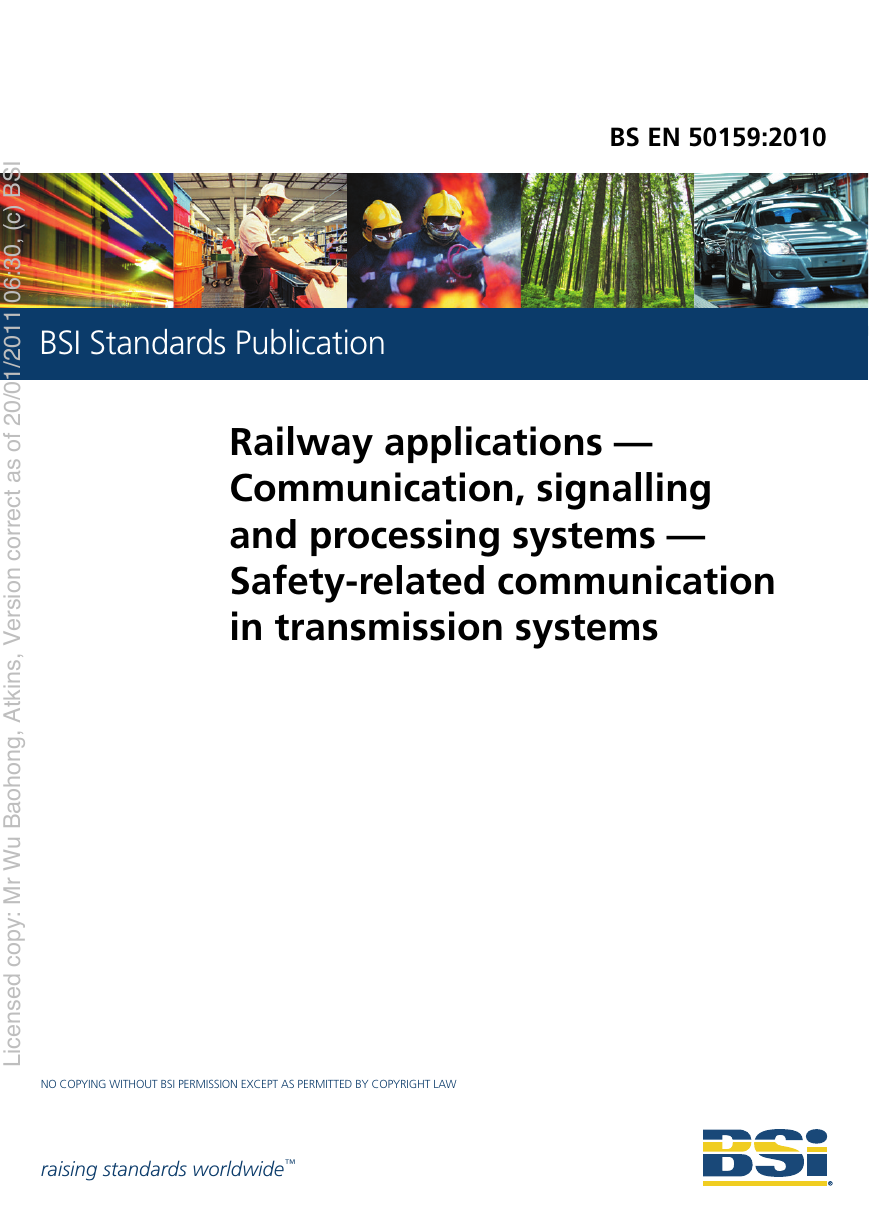
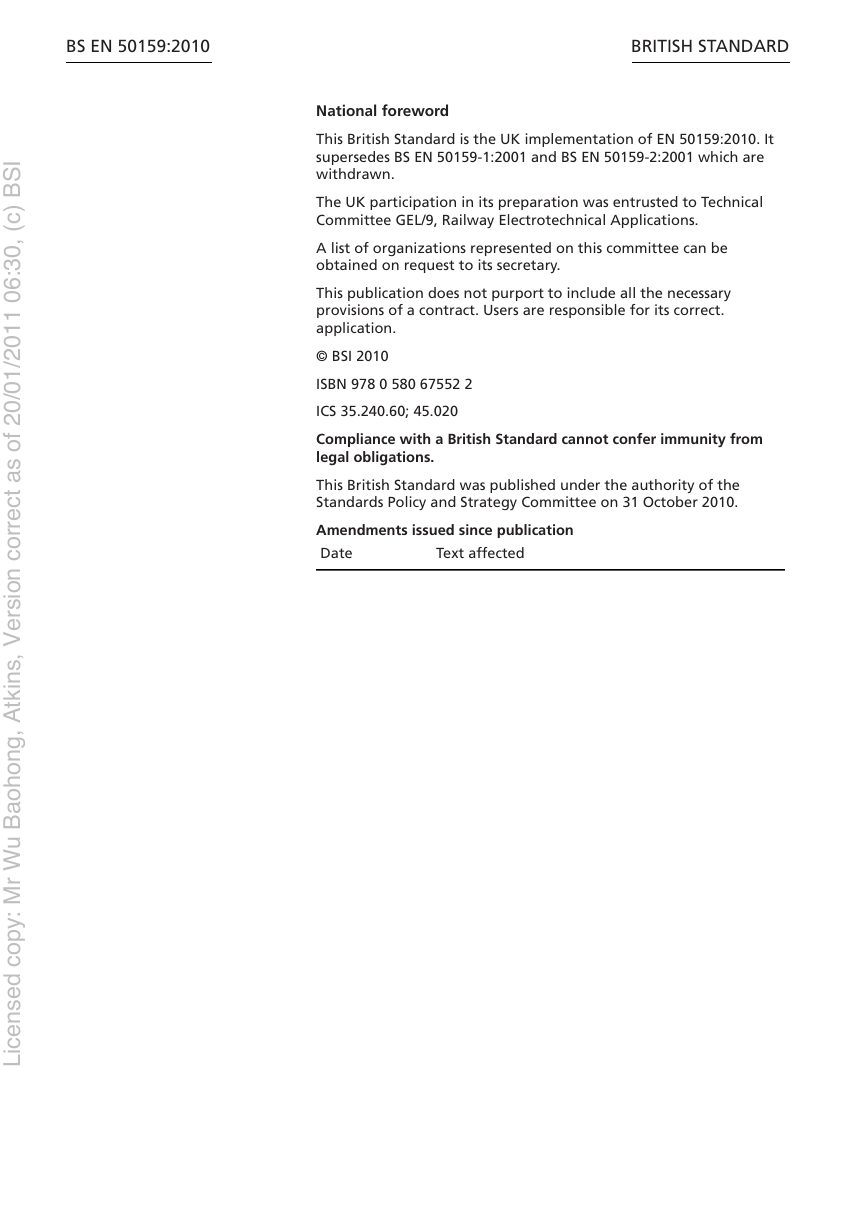
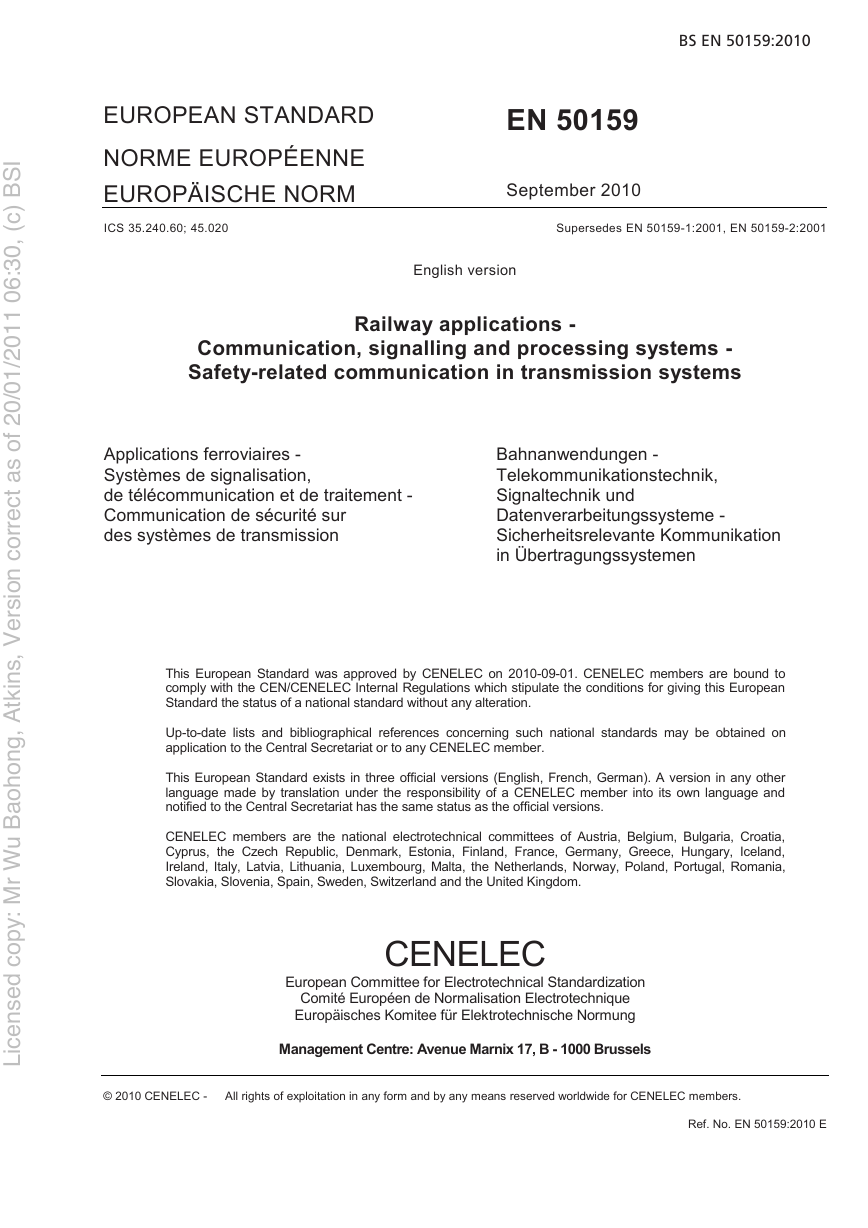
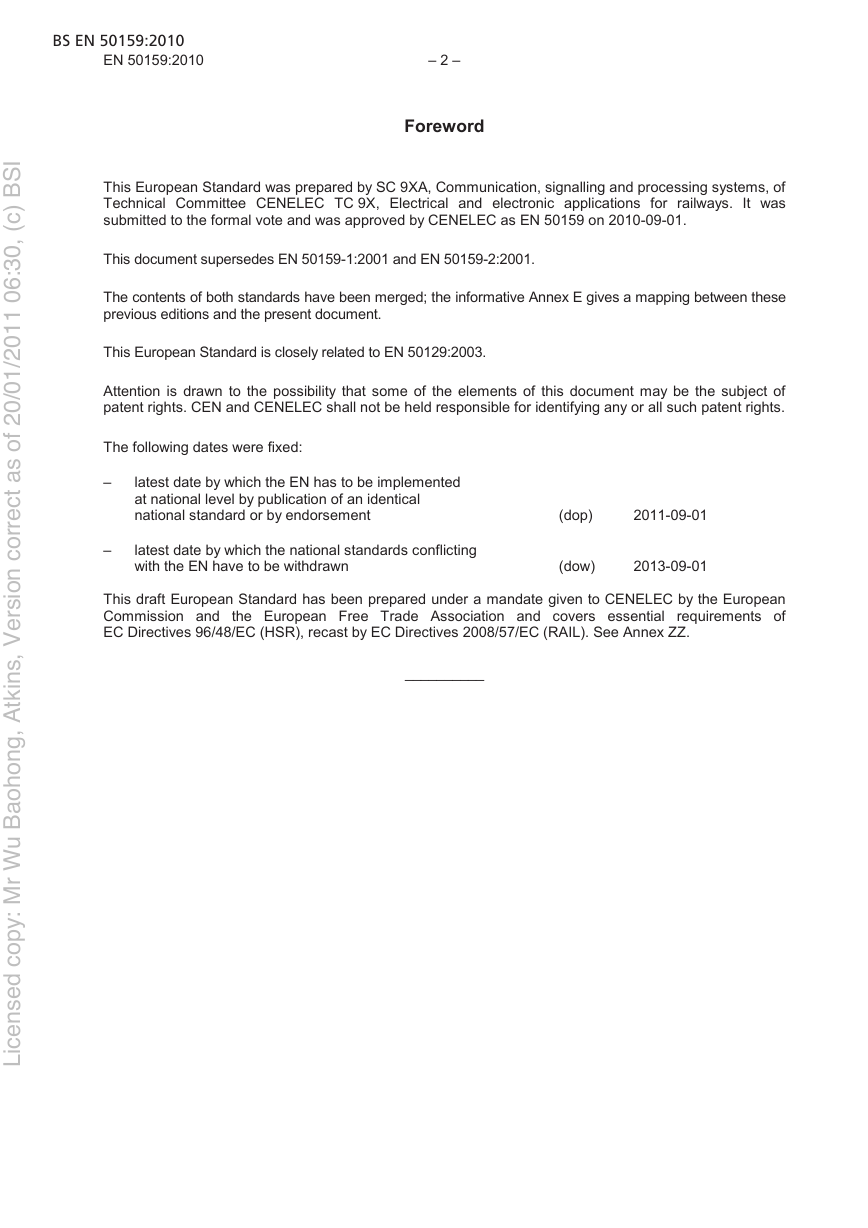

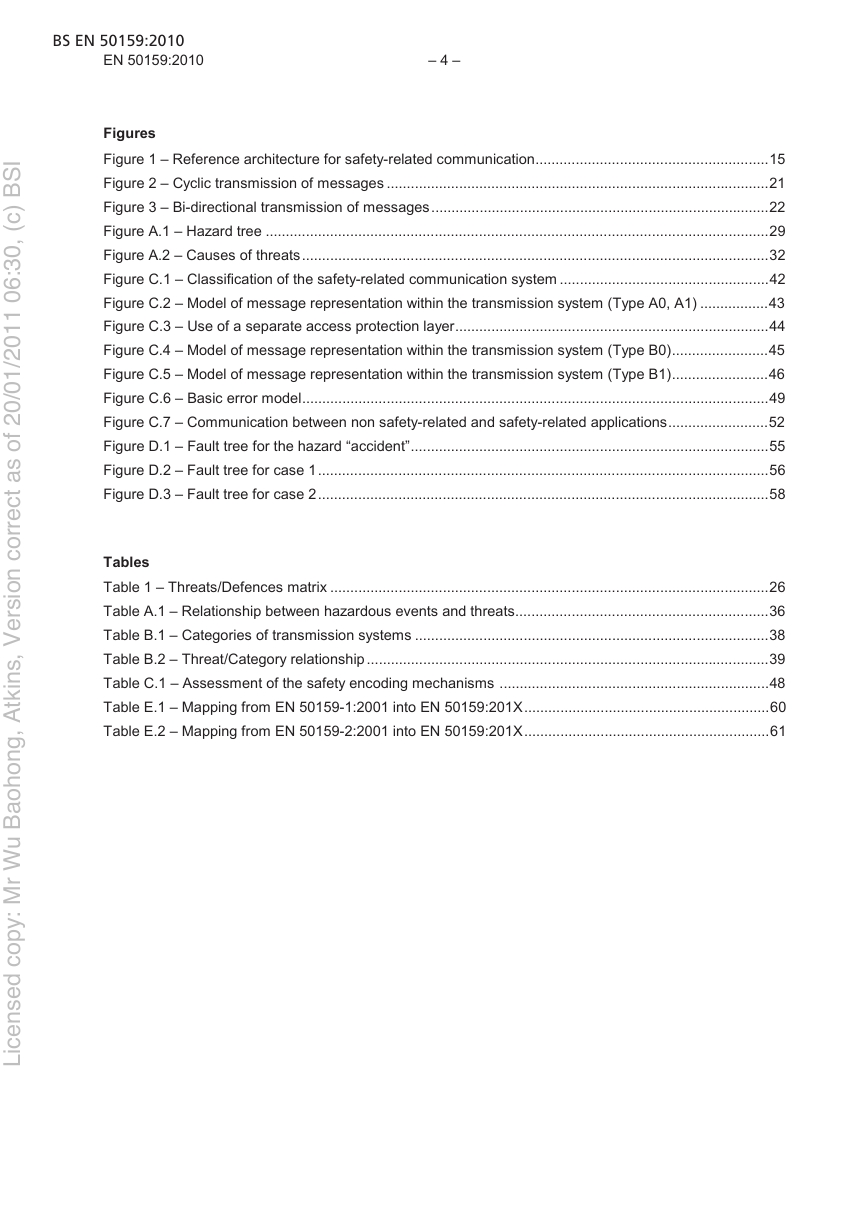
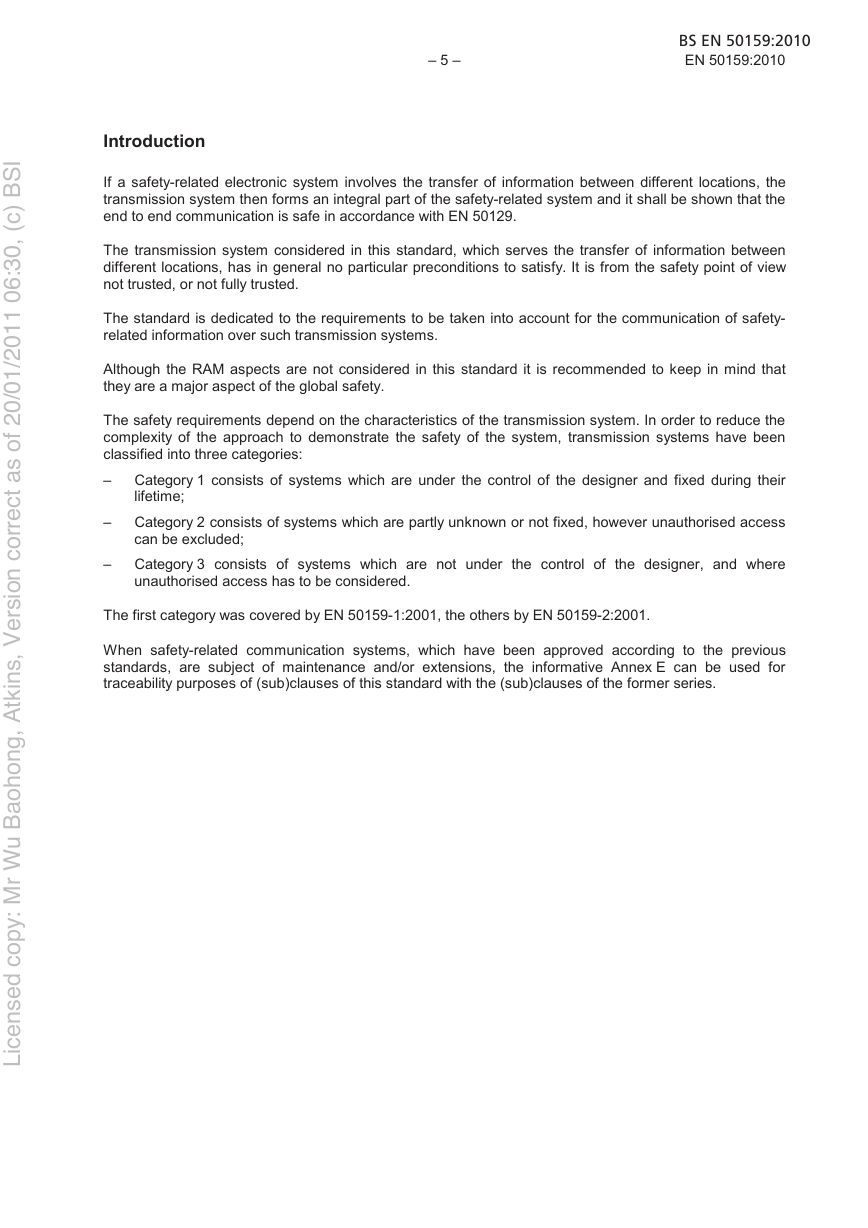









 2023年江西萍乡中考道德与法治真题及答案.doc
2023年江西萍乡中考道德与法治真题及答案.doc 2012年重庆南川中考生物真题及答案.doc
2012年重庆南川中考生物真题及答案.doc 2013年江西师范大学地理学综合及文艺理论基础考研真题.doc
2013年江西师范大学地理学综合及文艺理论基础考研真题.doc 2020年四川甘孜小升初语文真题及答案I卷.doc
2020年四川甘孜小升初语文真题及答案I卷.doc 2020年注册岩土工程师专业基础考试真题及答案.doc
2020年注册岩土工程师专业基础考试真题及答案.doc 2023-2024学年福建省厦门市九年级上学期数学月考试题及答案.doc
2023-2024学年福建省厦门市九年级上学期数学月考试题及答案.doc 2021-2022学年辽宁省沈阳市大东区九年级上学期语文期末试题及答案.doc
2021-2022学年辽宁省沈阳市大东区九年级上学期语文期末试题及答案.doc 2022-2023学年北京东城区初三第一学期物理期末试卷及答案.doc
2022-2023学年北京东城区初三第一学期物理期末试卷及答案.doc 2018上半年江西教师资格初中地理学科知识与教学能力真题及答案.doc
2018上半年江西教师资格初中地理学科知识与教学能力真题及答案.doc 2012年河北国家公务员申论考试真题及答案-省级.doc
2012年河北国家公务员申论考试真题及答案-省级.doc 2020-2021学年江苏省扬州市江都区邵樊片九年级上学期数学第一次质量检测试题及答案.doc
2020-2021学年江苏省扬州市江都区邵樊片九年级上学期数学第一次质量检测试题及答案.doc 2022下半年黑龙江教师资格证中学综合素质真题及答案.doc
2022下半年黑龙江教师资格证中学综合素质真题及答案.doc